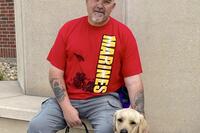Three days after a New Jersey Army National Guardsman died from COVID-19, and more than three weeks after they were activated to support their state's coronavirus response, members of the Maryland National Guard received guidance on the recommended steps they should take if they fall ill.
Maryland National Guard officials issued instructions Tuesday on COVID-19 medical tests and quarantines for troops. By that point, one Maryland Guard member had already tested positive, and at least 20 members were in quarantine.
A second member has since tested positive, according to a source with knowledge of the Maryland Guard's deployment to Baltimore. As a result, three more Guardsmen had to be placed in quarantine.
The troops have been helping set up COVID-19 test facilities, distributing food, supporting medical assessments and training for a broader response, as needed. But while these Guard members have been close to the front lines of the disease response effort, their own support system has been thin at times, or unclear.
Related: 1st US Service Member Dies of Coronavirus
At the start of their deployment, they received "conflicting guidance" from state Guard officials, leaving those without personal health coverage concerned about the cost of testing and treatment and confused over worker's compensation, which they would have qualified for during the state-wide call-up.
The mixed messages created confusion among troops and commanders, who weren't sure what to do with symptomatic members.
"There was a good bit of chaos, as you can imagine, on the front end of mobilization in terms of how, if the states were going to respond, they were going to be supported," said retired Mississippi Army National Guard Brig. Gen. Roy Robinson, president of the National Guard Association of the United States.
When National Guard members are serving at the request of their governors, they are considered state employees, entitled to benefits extended by the state.
Under certain conditions, however, the Defense Department can provide federal funding for state operations, under U.S. Code Title 32, Section 502 (f).
President Donald Trump granted Title 32 status on March 22 to National Guard operations in three states: California, New York and Washington.
On Sunday, the Federal Emergency Management Agency announced the addition of five more states, including Florida, Louisiana, Massachusetts, Maryland and New Jersey, as well as U.S. territories Guam and Puerto Rico.
The designation makes Guard members eligible for medical coverage at military treatment facilities and gives families the option of enrolling in the Tricare health program. While operating under Title 32, they accrue credits and time for GI Bill benefits and retirement and are eligible for a death gratuity from the DoD if they die on active duty.
On Tuesday, however, Maryland National Guard members seemed unaware of their newly designated federal status: The health guidance they were issued instructed them to "keep all documentation to ensure" they would receive state workers' compensation.
"I had a lot of concerns bringing up the Guard under state active-duty status, because they don't get federal benefits associated with their service. And in this particular case, it's even more severe, because some of these soldiers may not have personal health insurance," Robinson said.
As of Sunday, nearly 15,000 Army and Air National Guard members supporting COVID-19 operations across the U.S. Guard components have been activated in all 50 states; the U.S. Virgin Islands; Washington, D.C.; Guam; and Puerto Rico. Just 10 locations are operating under Title 32 status.
On Friday, Defense Secretary Mark Esper issued a letter to state governors saying he had approved modifications to accelerate the process by which they could receive federal support under Title 32.
"This authorization enables your timely use of the National Guard to save lives and protect public health and safety," Esper wrote. "The men and women of the National Guard are citizen-soldiers who stand ready to serve their communities as we fight COVID-19."
Robinson said that, with the letter signed by Esper, the National Guard Association of the United States will now work to increase the length of troops’ orders, to ease the burden on unit administrative sections, as well as service members.
Currently, the mobilized troops are operating under 30-day orders. Robinson said he will work to have the orders written for a longer period since, historically, National Guard families have experienced lapses in medical care when their service members are activated or their deployments extended.
"Making the transition can be cumbersome. At times, we've seen a break in their care, their pay -- everything associated with being on short-term orders can be very cumbersome for the units and administrative personnel. Frankly, we see a lot of issues," Robinson said.
Still, he added, regardless of the length of time they are mobilized, Guard members will perform in this time of national crisis.
"I stand in awe of the men and women of the National Guard and what they are doing right now. There are about 2,500 members on the border mission. ... We've got members deployed to Afghanistan and Iraq. We have them in peacekeeping missions in Bosnia and the Sinai. In every case, when the members of the National Guard are called upon, they bring calm to chaos."
-- Patricia Kime can be reached at patriciankime@gmail.com.
Read More: 'Sailors Do Not Need to Die': Carrier Captain Pleads for Help as Virus Cases Surge














